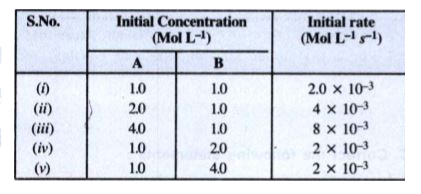In the reaction given in euaqution
Zn(s)+PbCl
2
(aq)→Pb(s)+ZnCl2
(aq)
mention:
I. Which reactant is oxidised? To what?
II. Which reactant is the oxidiser?
III.Which reactant is reduced? To what?
IV. What reactant is the reducer?
The correct Answer is:A
To analyze the redox reaction given in the equation:
Zn(s) + PbCl₂(aq) → Pb(s) + ZnCl₂(aq)
we need to identify the oxidation and reduction processes involved. Let's break it down step by step.
Step 1: Identify Oxidation States
- Zinc (Zn) starts as a neutral element (0 oxidation state) and ends up in ZnCl₂ where it has an oxidation state of +2.
- Lead (Pb) in PbCl₂ has an oxidation state of +2 and ends up as a neutral element (0 oxidation state).
Step 2: Determine Oxidation and Reduction
- Oxidation is the process where a substance loses electrons. Here, Zn is oxidized from 0 to +2, losing 2 electrons:
Zn→Zn2++2e−
- Reduction is the process where a substance gains electrons. Here, Pb^{2+} is reduced from +2 to 0, gaining 2 electrons:
Pb2++2e−→Pb
Step 3: Identify the Reactants
1. Which reactant is oxidized? To what?
- Zn is oxidized to Zn²⁺.
2. Which reactant is the oxidizer?
- Pb²⁺ is the oxidizer because it gains electrons.
3. Which reactant is reduced? To what?
- Pb²⁺ is reduced to Pb.
4. What reactant is the reducer?
- Zn is the reducer because it donates electrons.
Final Answers:
I. Zn is oxidized to Zn²⁺.
II. Pb²⁺ is the oxidizer.
III. Pb²⁺ is reduced to Pb.
IV. Zn is the reducer.
---
- Zinc (Zn) starts as a neutral element (0 oxidation state) and ends up in ZnCl₂ where it has an oxidation state of +2.
- Lead (Pb) in PbCl₂ has an oxidation state of +2 and ends up as a neutral element (0 oxidation state).
- Oxidation is the process where a substance loses electrons. Here, Zn is oxidized from 0 to +2, losing 2 electrons:
Zn→Zn2++2e−
- Reduction is the process where a substance gains electrons. Here, Pb^{2+} is reduced from +2 to 0, gaining 2 electrons:
Pb2++2e−→Pb
1. Which reactant is oxidized? To what?
- Zn is oxidized to Zn²⁺.
- Pb²⁺ is the oxidizer because it gains electrons.
- Pb²⁺ is reduced to Pb.
- Zn is the reducer because it donates electrons.
I. Zn is oxidized to Zn²⁺.
II. Pb²⁺ is the oxidizer.
III. Pb²⁺ is reduced to Pb.
IV. Zn is the reducer.
Topper's Solved these Questions
- REDOX REACTIONSBOOK - CENGAGE CHEMISTRY ENGLISHCHAPTER - REDOX REACTIONSEXERCISE - Exercises (Linked Comprehension)
24 Videos
- REDOX REACTIONSBOOK - CENGAGE CHEMISTRY ENGLISHCHAPTER - REDOX REACTIONSEXERCISE - Exercises (Multiple Correct)
32 Videos
- REDOX REACTIONSBOOK - CENGAGE CHEMISTRY ENGLISHCHAPTER - REDOX REACTIONSEXERCISE - Ex 2.2
18 Videos
- PURIFICATION OF ORGANIC COMPOUNDS AND QUALITATIVE AND QUANTITATIVE ANALYSISBOOK - CENGAGE CHEMISTRY ENGLISHCHAPTER - PURIFICATION OF ORGANIC COMPOUNDS AND QUALITATIVE AND QUANTITATIVE ANALYSISEXERCISE - Assertion Reasoning Type
5 Videos
- S-BLOCK GROUP 1 - ALKALI METALSBOOK - CENGAGE CHEMISTRY ENGLISHCHAPTER - S-BLOCK GROUP 1 - ALKALI METALSEXERCISE - Archives Subjective
8 Videos
Similar Questions
Knowledge Check
1g of Mg is burnt in a closed vessel which contains 0.5gofO2
(i) Which reactants is left in excess
(ii) Find the mass of the excess reactant.AO2 is a limiting reagent and Mg is in excess by 0.25 g.BMg is a limiting reagent and is in excess by 0.5 g.CO2 is a limiting reagent and is in excess by 0.25 g.DO2 is a limiting reagent and Mg is in excess by 0.75 g.
For the reaction,
Zn(s)+2HCl(aq)→ZnCl2(aq)+H2(g),ΔH is equal to ΔE.
View SolutionWhat is the concentration of the reactant in a first order reaction when the rate of the reaction is 0.6 s-1 and the rate constant is 0.035?
View SolutionA reaction is of second order with respect to its reactant. How will its reaction rate be affected if the concentration of the reactant is (i) doubled (ii) reduced to half ?
View SolutionA reaction is of second order with respect to its reactant. How will its reaction rate be affected if the concentration of the ractant is (i) doubled (ii) reduced to half ?
View SolutionThe half life for a given reaction was doubled as the initial concentration of a reactant was doubled. What is the order of reaction.
View SolutionConsider the reaction, A+B→C+D.
The initial rate for different initial concentrations of the reactants are given below :

What is the overall order ?
View SolutionConsider the reaction, A+B→C+D.
The initial rate for different initial concentrations of the reactants are given below :

What is the overall order ?
View Solution
